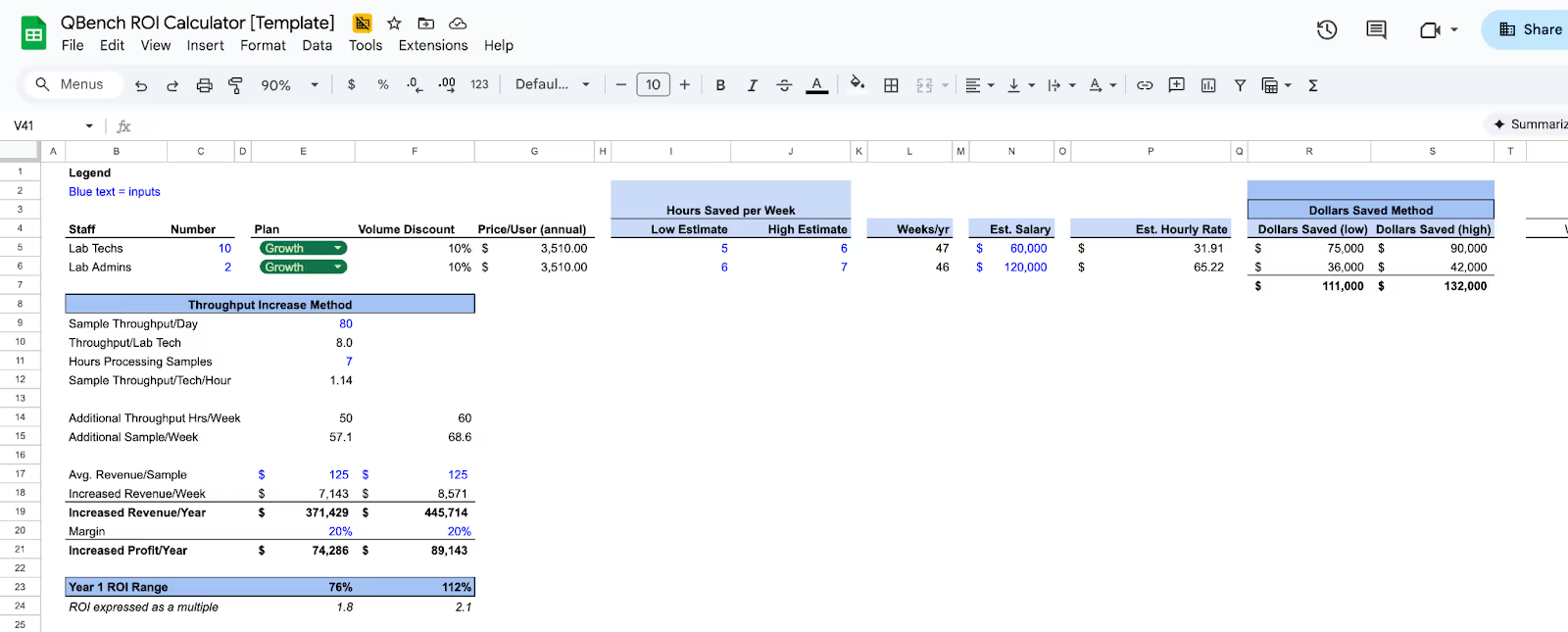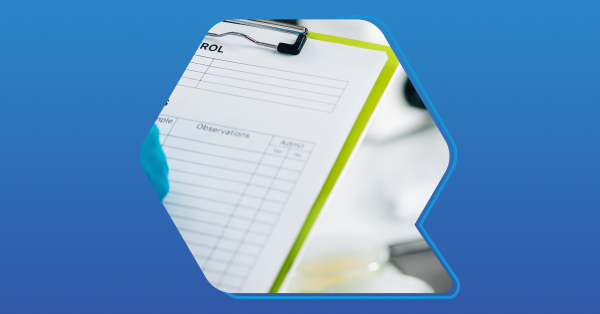How to Make a Business Case for a LIMS in Your Lab

Most lab managers already know they need a LIMS. The hard part is getting the executive team to earmark tens of thousands of dollars to invest in one.
For many labs we talk to, cost is often a sticking point that prevents them from taking the leap from physical lab notebooks, shared Google Sheets, and whiteboards to specialized software.
What they’re not asking (at least not right away) is what is the cost of sticking with their time-intensive and error-prone systems? In this article, we’ll showcase these hidden costs of not switching to a LIMS and give you a blueprint for making a business case for a LIMS to your executive team.
The Financial Impact of a LIMS: What it Costs to Not Invest in One
Yes, compared to paper notebooks (which can be a few dollars) or Excel (usually $70 or so per year), a LIMS (hundreds to tens of thousands per year) can seem expensive.
But that’s ignoring the hidden costs of not adopting a digital system of record for your lab.
A LIMS isn’t cheap. But neither is repeated rework, failed audits, or an overwhelmed lab team wasting 20% of their time on admin. The real question isn’t ‘can we afford a LIMS?’ – it’s ‘can we afford not to have one?
Whether you're facing an EPA inspection as an environmental lab, a client audit as a contract testing facility, or FDA scrutiny in manufacturing, the risks of relying on duct-taped systems are similar and ever-present.
A LIMS is a cost-saver, not a cost-sink. Manual data entry isn’t the problem, so much as the downstream effects from the errors it introduces.
- Reduce costly errors: Data entry errors seem innocuous in the moment, but uncaught, they lead to sample chain of custody failures, the ability to trace test results, or data integrity errors that shut down production. Sure, you could prevent these with extensive training, double, or even triple-checking work, and routine audits, but that also adds an immense amount to your already full plate.
- Eliminate hours of busy work: Error-prevention is one thing, but let’s not forget the hours saved by eliminating data entry altogether. Hours spent generating reports, transcribing readings, or re-running tests could be put to better use, like servicing more clients or expanding your suite of services. With a LIMS, you can cut as much as seven hours per week for each member of your staff.
- Free you up to scale: This data management and reporting shoulders the cognitive load that comes with managing information and processes, freeing labs up to scale their throughput or expand. This isn’t just marketing-speak about hypothetical benefits; it’s been proven that the efficiencies driven by a LIMS can result in 30% reductions in some laboratory development timelines.
These aren’t hypothetical constructions; they’re grounded concerns you need to prepare for.
For instance, just look at a 2024 FDA Warning Letter to a contract testing lab in Uruguay. The inspection revealed significant GMP violations caused by incomplete lab records, unreviewed out-of-specification results, and a lack of controls over electronic data.
This lab was flying blind and paid a steep price for it. Compliance failures lead to costly time spent remediating issues and serious reputational harm, which can lead to lost trust and confidence from customers.
The ROI of a LIMS
Every lab is a little different, yet the economic levers are always the same: people, throughput, and re-work. Fine-tuning those levers isn’t easy — data sit in multiple systems, and every tweak has downstream effects—but a robust LIMS brings them into one place and nudges all three in the right direction. That’s the theory; here’s a conservative, back-of-the-napkin view of what the payoff can look like.
Let’s assume the following about a hypothetical lab:
- The staff includes 10 techs and two admins
- The estimated annual salary for each tech is $60K per year
- The estimated annual salary for each tech is $120K per year
- The lab processes 80 samples per day
- Technicians spend about 7 hours processing samples per day
- The LIMS saves techs 5–6 hours per week and admins 6–7 hours per week (this is the low-end estimate of what our customers have told us a modern LIMS saves them)
Then let’s say that a LIMS could drive the following outcomes:
- 50-60 total technician hours saved per week for the 10 technicians
- 12-14 total admin hours saved per week for the 2 admins
- Increased capacity for 57 more samples processed each week. We’re assuming the above technicians are not so busy babysitting spreadsheets that they can get more important work done.
In terms of time saved across the 10 techs and two admins, this results in savings of $111,000 to $132,000 each year. When we account for the cost of QBench (roughly $42,000 for a lab this size), we get an ROI range of 164% to 213% (or 2.6x to 3.1x)! In other words, the software pays for itself before your staff heads out on summer vacation. Scale the lab size up or down, and you’ve still got a very compelling case for putting in a LIMS as soon as possible.
What could you do with all these savings?
- Invest in new equipment
- Hire more staff
- Invest in R&D
- Invest in marketing/sales to expand your customer base
- Hire fewer staff as you scale because each technician is more productive
Don’t take our word for it, though. The above estimates come from a spreadsheet we developed to generate an ROI estimate based on a lab’s size, industry, and processes. See the template pictured below.

If you’re a contract testing lab that measures ROI based on increased revenue, then we have a spreadsheet for calculating increased sample throughput, factoring in your margin, and measuring ROI based on increased profit per year.
For a contract testing lab, let’s assume the following:
- The staff includes 10 techs and two admins
- The estimated annual salary for each tech is $60K per year
- The estimated annual salary for each tech is $120K per year
- The lab processes 80 samples per day before a LIMS
- Technicians spend about 7 hours processing samples per day
- The LIMS saves techs 5–6 hours per week, and they repurpose that into higher sample throughput
- The average revenue per sample is $125, and the profit margin is 20%
The LIMS could create these end results:
- 12-14 total admin hours saved per week for the two admins
- 50-75 total technician hours of additional throughput capacity per week across the 10 technicians, resulting in an additional 57 to 69 samples processed per week
Using the revenue and margin assumptions above, that translates into roughly a $74,000 to $89,000 bump in annual profit. When we account for the cost of QBench, we get an ROI range of 76% to 112% (or 1.8x to 2.1x) per year! See the template example below.

Ready for Numbers that Will Impress Your CFO?
Generic calculators are fine for napkin math, but real approval comes from real lab data: your actual margins, labor costs, and re‑work rates. We offer a free, no‑obligation ROI assessment that starts with brief staff surveys and ends with a business case your finance team can trust. Let us help build you a proposal that will knock the socks off your CFO.
Ready for a custom estimate? Share a few details about your workflow in the form below, and we’ll schedule a call to run the numbers together.
Seeing those dollars and cents start to make sense? Next, we’ll share how to make a strong and compelling business case for a LIMS.
ROI in Action: Meet Light Labs
Jonah, Founding Engineer of Light Labs, is on a mission to improve the quality and health of the food industry. It’s an ambitious goal, to be sure, and to achieve this mission, the Light Labs team needed software that empowered them and gave them the flexibility they needed to automate key processes and share results with clients.
That meant an ultra-fast and modern LIMS that supported:
- High-throughput data capture
- Client-facing self-service functionality
- No-code tools to configure workflows
- A fast implementation to hit the ground running
Here’s what Jonah had to say about his experience:
“Onboarding with QBench was great. We had everything up and running quickly for processing tests and samples, and then we have been iterating from there. We started with a simple setup and have been able to scale QBench alongside us as our processes have grown more complex.”
The combination of Light Labs’ dedication to the project and QBench’s ease of configuration enabled the project to go from kickoff to a system ready to process samples in about 40 days!
Today, Light Labs serves household names like David Protein, Banza, Kettle & Fire, and more. Read the rest of Jonah’s story.
A Step-by-Step Guide to Building Your Business Case for a LIMS
The exact steps you follow will depend on the structure of your lab (and your role), but we’ve found that the following are helpful for crafting a compelling business case for a LIMS:
- Define the problem and goals
- Quantify the benefits and ROI
- Estimate costs
- Assess risks and objections
Define the Problem and Goals
A good executive presentation starts with clear documentation of the pain points your staff experiences and the measurable impacts a LIMS could make.
Take time to document the specific areas that slow your team down or trip them up. It could be error rates caused by manual data entry, hours spent searching for samples, test failure rates, compliance audit findings – choose anything that is measurable.
Then frame your goals around business outcomes. Instead of broad, hand-wavy phrasing like “reduce paperwork,” be specific. Something like "accelerate time-to-market by eliminating manual transcription delays" will land much better. The clearer you can tie lab efficiency to revenue impact or regulatory compliance, the better your chances of being heard.
Quantify Benefits and ROI
The previous step is a good primer for defining ROI-centric objectives, but the best way to drive home the point and earn the attention of your entire executive team is to calculate the benefits that a LIMS can provide.
Remember, these are business-oriented members of your company who want hard data and not generalized software benefits. These could be any of the following:
- Reduced labor costs
- Increased throughput and TAT
- Improved customer retention
- Time saved by staff from manual data entry
For a mid-sized lab, annual savings could range from $100,000 to $500,000 – a significant ROI opportunity for most LIMS.
Estimate Costs (TCO)
Next, it’s helpful to compare the money saved (or generated) with the total cost of ownership (TCO) to make it clear that this is an ROI-positive investment for your lab.
A LIMS isn’t like a CRM or time tracking software. You’re paying for more than the annual fees, for instance, you need to account for:
- Implementation costs
- Additional training (if needed)
- Annual fees (either a subscription or license for self-hosted software)
- Development fees if your LIMS is not configurable
These costs will come up through the sales process, so make sure to ask as you evaluate vendors to paint a clear and compelling picture for your executive team.
It’s worth noting that an on-prem self-hosted LIMS will incur additional costs beyond the licensing fees. You’ll need to factor in hosting costs, as well as development costs to maintain or alter the platform, and security costs as well.
Address Risks and Objections
Finally, prepare in advance for any risks that could be raised or objections (we’ll dive deeper into the latter in the next section).
Common risks and concerns you will hear may include:
- Budget concerns
- Change management and associated costs
- Data migration challenges (and again, costs)
- Regulatory risks
- Staff training, both the time and the costs associated with it
It’s important not to overlook the risks. Instead, we recommend acknowledging them as they come up and being ready to present mitigation strategies for each one. This shows you've thoroughly considered implementation challenges and have realistic solutions.
Where possible, use storytelling techniques with concrete scenarios: "When we receive an urgent customer request, instead of spending two hours manually searching through paper records, staff can retrieve complete sample histories in under five minutes." Make the benefits tangible and personally relevant to each stakeholder group.
Tips for Presenting Your Business Case to Executives
Those building blocks will give you a solid foundation for your business case, but to make your case even more compelling, we recommend bearing the following tips in mind.
- Keep it concise: Limit your presentation to 10-15 slides maximum and prepare a one-page executive summary. If you can't make your case in 15 minutes, you haven't distilled it to the essential elements.
- Focus on strategic objectives: Align every benefit to your organization's current strategic priorities. This frames the LIMS as a contributor to the larger business strategy rather than just a lab improvement project.
- Anticipate common questions: Prepare specific answers for predictable concerns like "Why now?" and "What's the implementation timeline?" with backup slides containing detailed specifications and risk mitigation plans.
- Use visuals: Replace text-heavy slides with charts showing current vs. future state workflows and ROI projections. A simple flowchart is more compelling than paragraphs describing efficiency gains.
Common Objections You May Hear – And Answers
Alas, even the most compelling slide deck presented by famed director and actor Sir Kenneth Branagh could fall on deaf ears.
You will probably hear objections from members of your executive team, and that’s fine. You need to be prepared for their objections and have an effective response ready. Here are the following objections we’ve seen come up with answers you can use/modify.
"We don't have the budget for this right now." This is the old standby from executives resistant to investing in new technology. To work around this, first acknowledge that this is a decision that requires commitment and frame the discussion around the cost of not acting. Manual errors, compliance risks, and wasted inventory cost much more money in the long run.
"Our current system works fine." Another old favorite. Sure, you have gotten this far with Excel files or shared Google Drives, but the key is to show that while the current processes are functioning to a degree, they’re not enough to scale your operations or meet compliance regulations. Make sure to quantify the hidden costs of "fine,” ie, time spent on manual tasks, error rates, delayed reporting, and missed opportunities that LIMS would eliminate.
"What if the system fails or doesn't work as promised?" Present your vendor evaluation criteria, reference implementations at similar organizations, propose pilot programs or proof-of-concept phases, and outline contractual protections and rollback plans.
"Why can't we just improve our current processes instead?" Compare the long-term costs and limitations of manual process improvements versus the scalable, sustainable benefits of automated systems that grow with the organization.
Remember: when you hear an objection, listen first, then reframe rather than responding right away. Objections and stated risks are not designed to poke holes in your presentation as much as they are your audience trying to understand or share their point of view.
Request a Free LIMS ROI Assessment
A LIMS is a significant investment, but it’s a necessary and worthwhile one for labs looking to scale.
Spreadsheets and notebooks can only get you so far. Without the tools to collect, analyze, and store vast amounts of data in a single, centralized place, no lab can make data-driven decisions to capitalize on improved accuracy and efficiency.
By taking a business-centric approach to the conversation and framing your points as necessary strategic objectives rather than nice-to-haves, you can steer the conversation with your executive team in your favor. And there’s no better way to do that than firm numbers behind the expected ROI.
Fill out the form below to request a free LIMS ROI assessment. We’ll collect some information about your lab and current bottlenecks, and provide a personalized report to show how much a LIMS can save you.








